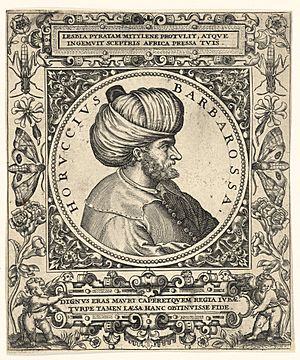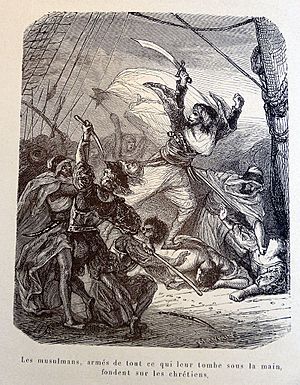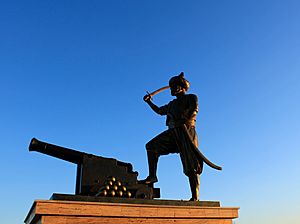Oruç Reis facts for kids
Quick facts for kids
Oruç Reis
|
|
|---|---|
 |
|
| Born | c. 1474 Midilli, Ottoman Empire (modern-day Lesbos, Greece)
|
| Died | May 1518 (aged 43–44) Tlemcen (in modern-day Algeria)
|
| Piratical career | |
| Nickname | Barbarossa Red Beard Baba Oruç |
| Years active | c. 1495 – 1518 |
| Rank | Sultan of Algiers |
| Base of operations | Mediterranean |
| Battles/wars |
|
Oruç Reis (born around 1474 – died 1518) was a brave Ottoman sailor and corsair. He later became the Sultan of Algiers. He was the older brother of the famous Ottoman admiral Hayreddin Barbarossa. Oruç Reis was born on the Ottoman island of Midilli, which is now Lesbos in Greece. He died fighting the Spanish in Tlemcen.
He became known as Baba Oruç or Baba Aruj, meaning Father Oruç. This name was given to him because he helped many Morisco, Muslim, and Jewish refugees. He transported them from Spain to safer lands in North Africa. In Europe, this name changed into Barbarossa, which means Redbeard in Italian.
Contents
Early Life and Family
Oruç Reis's father, Yakup Ağa, was an Ottoman official. He was involved in the Ottoman takeover of Lesbos in 1462. As a reward, he received land on the island. He married a local Greek woman named Katerina.
Yakup and Katerina had two daughters and four sons: Ishak, Oruç, Hızır, and Ilyas. Their father became a potter and bought a boat to sell his goods. All four sons helped with the family business. Oruç helped with the boat, while Hızır worked with pottery.
A Family of Seafarers
All four brothers became seamen. They worked in sea trade and marine affairs. Oruç was the first to become a sailor. His youngest brother, Ilyas, soon joined him. Hızır later got his own ship and also started a career at sea. Ishak, the oldest, stayed on Mytilene. He managed the family's money.
The three younger brothers became privateers in the Mediterranean Sea. They fought against the privateers from the Knights Hospitaller of Rhodes. Oruç and Ilyas sailed between Anatolia, Syria, and Egypt. Hızır mostly sailed in the Aegean Sea.
Oruç was a very successful sailor. He learned to speak Italian, Spanish, French, Greek, and Arabic.
Captured by Knights
During a trading trip, Oruç and Ilyas were attacked by the Knights Hospitaller. Ilyas was killed in the fight. Oruç was hurt and taken prisoner. He was held in the Knights' Bodrum Castle for almost three years. Hızır tried to rescue him but couldn't. Oruç was tortured at first. Later, he worked as a slave on a ship. One night, he managed to escape. He fled to a village and later joined another captain.
Oruç the Corsair
Oruç later went to Antalya. There, an Ottoman prince named Şehzade Korkut gave him 18 ships. Oruç was tasked with fighting the Knights Hospitaller. They were causing problems for Ottoman shipping.
Later, the prince gave Oruç a larger fleet of 24 ships. Oruç then joined an Ottoman naval trip to Italy. He attacked several forts and captured two ships. On his way back, he captured more ships. He also attacked islands controlled by the Knights Hospitaller.
Oruç then sailed to Egypt. He met the Mamluk Sultan Al-Ashraf Qansuh al-Ghawri. The Sultan gave him another ship. He told Oruç to raid the coasts of Italy and other Christian-controlled islands.
A New Base in North Africa
In 1503, Oruç captured three more ships. He made the island of Djerba his new base. This moved his operations to the Western Mediterranean. Hızır joined Oruç at Djerba. In 1504, the brothers asked the ruler of Tunisia for permission to use the port of La Goulette. They were allowed, but had to give one-third of their treasures to the sultan.
Oruç captured two large Papal ships near Elba. Later, the brothers captured a Sicilian warship. It had 380 Spanish soldiers and 60 knights on board. In 1505, they raided the coasts of Italy. Their fame grew, and other Muslim corsairs joined them.
In 1509, Ishak also joined his brothers at La Goulette.
Helping Refugees: Baba Oruç
Oruç's fame grew even more between 1504 and 1510. During this time, he transported many Muslims from Spain to North Africa. He helped these people in need. This earned him the honorable name Baba Oruç (Father Oruç). Over time, this name became Barbarossa (Redbeard) in Spain, Italy, and France.
In 1510, the three brothers raided Sicily. They also fought off a Spanish attack on Bougie, Oran, and Algiers. In 1512, Oruç lost his left arm in a battle. This earned him the nickname Gümüş Kol (Silver Arm). He used a silver prosthetic arm.
Later that year, the brothers raided the coasts of Spain. They captured many ships. They also landed on Menorca and captured a castle. They captured a total of 23 ships in less than a month.
They built more ships and a gunpowder factory. In 1513, they captured English and Spanish ships. Between 1513 and 1514, the brothers fought Spanish groups many times. They moved their base to Cherchell, west of Algiers. In 1514, with 12 ships and 1,000 Turkish fighters, they destroyed two Spanish forts. They also captured Jijel in Algeria and Mahdiya in Tunisia. They raided the coasts of Sicily, Sardinia, and Spain.
In 1515, Oruç sent gifts to the Ottoman Sultan Selim I. In return, the Sultan sent him two ships and two swords. In 1516, the brothers attacked the Castle of Elba. They then went to Italy, where they captured 12 ships.
Leader of Algiers
In 1516, the three brothers successfully freed Jijel and Algiers from the Spanish. They then took control of these cities and the surrounding area. The local Spanish people in Algiers asked Emperor Charles V of Spain for help. But the Spanish fleet could not force the brothers out of Algiers.
Oruç became the new Sultan of Algiers. He expanded his territory inland, taking Miliana, Medea, and Ténès. He was known for putting sails on cannons to move them across the North African deserts. In 1517, the brothers raided towns in Italy.
In 1518, Oruç Reis conquered Oujda and Tibda in eastern Morocco. He made alliances with the Sultan of Morocco.
His Final Battle
The Spanish ordered Abu Zayan, the ruler of Tlemcen, to attack Oruç. But Oruç learned of the plan. He attacked Tlemcen first, capturing the city and executing Abu Zayan in 1518. Sheikh Buhammud, the only survivor of Abu Zayan's family, escaped to Oran. He asked Spain for help.
In May 1518, Emperor Charles V arrived in Oran. He had 10,000 Spanish soldiers. They marched towards Tlemcen. Oruç and Ishak waited for them with 1,500 soldiers and 5,000 Moorish soldiers.
Oruç Reis defended Tlemcen for six months. He was betrayed by some local people. He tried to break through the enemy's siege to return to Algiers. He managed to break through and cross a river with some of his men. However, about twenty of his men were left behind. Oruç Reis, knowing he had little hope, went back to fight with his men. Most of his men died trying to cross the river. Oruç Reis, who had only one arm, died from a spear wound after seeing his last man fall.
The Spanish wanted to prove Oruç Reis was dead to the King of Spain. They cut off his head and preserved it in honey. They took it to Spain. They did this because they had falsely reported his death many times before.
Oruç's last remaining brother, Hızır (Hayreddin Barbarossa), took his place. He inherited the name Barbarossa and continued his mission. He became a very powerful and famous Ottoman admiral. He helped the Ottoman Empire control the Mediterranean Sea in the 16th century.
Oruç Reis's Legacy
Oruç Reis helped establish the Ottoman presence in North Africa. This presence lasted for four centuries. It ended when France took Algeria in 1830, Tunisia in 1881, and Italy took Libya in 1912.
Three submarines of the Turkish Navy have been named after Oruç Reis: TCG Oruç Reis, TCG Oruçreis (S-337), and TCG Oruçreis (RAD-14).
In 2018, a statue of Oruç Reis was put up in Aïn Témouchent, Algeria.
See also
- Ottoman Navy
- Oruç Reis-class submarine
- TCG Oruçreis (F-245)



